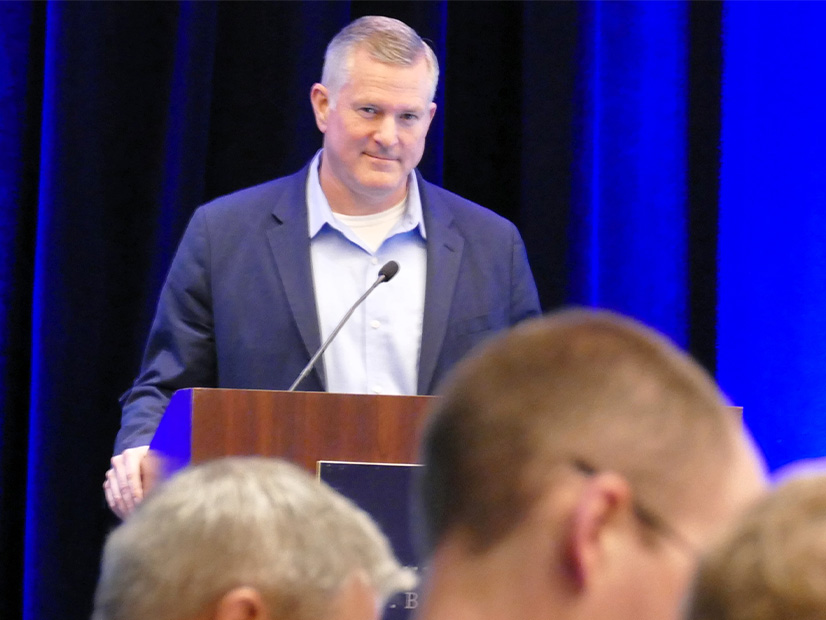Members Pass Last of HITT’s 2019 Recommendations
HOUSTON — SPP’s Markets and Operations Policy Committee has endorsed the last of 21 recommendations made by a task force that reviewed the RTO’s transmission and market operations in the last decade.
The proposed tariff change (RR665) would establish “subregions” for the cost allocation of future byway (between 100 and 300 kV) upgrades.
“It’s been a long time coming,” Evergy’s Derek Brown, a supporter of the revision request, said during MOPC’s April meeting. “We just need to know the size of the subregions, which we now have.”
SPP said the tariff change could be implemented next year, once it receives approval from the Board of Directors, state regulators and FERC.
“I’ll just share Evergy’s opinion that we should try and move faster than that, if possible,” Brown said. “The policy has been approved for a long time now. We have some of the largest portfolios we’ve ever seen that we just went through the last few years, and we have another large one, potentially, in the 2025 [Integrated Transmission Planning assessment]. Cost allocation has a big impact on those discussions.”
The change, as developed by the Cost Allocation Working Group’s state regulatory staff, would decouple SPP’s Schedule 9 (zonal rates) and Schedule 11 (highway/byway) transmission pricing zones and create larger Schedule 11 subregions of existing zones. Two-thirds of the cost of byway upgrades would be allocated to the subregion where they are connected, with the remaining 33% allocated to the SPP footprint.
Similar to 300-kV and above highway projects, new base plan upgrades larger than 300 kV would be allocated RTO-wide.
The change must be approved by the board and Regional State Committee when they meet May 5.
MOPC approved the proposed tariff change with 75.99% approval. Six of 17 transmission owners and seven of 55 transmission users voted against it.
SPP’s board created the Holistic Integrated Tariff Team (HITT) in March 2018 to conduct a comprehensive review of the grid operator’s cost-allocation model, transmission planning processes, Integrated Marketplace and real-time operations. After a year of discussion, the 15-person HITT published a report with 21 recommendations. (See HITT Shares Draft Report with SPP Stakeholders.)
The tariff change was hung up for several years by work on another HITT recommendation to adopt a policy creating an appropriate balance between cost assessed and value attained from energy and network resource interconnection service products and generating resources with long-term firm transmission service.
“Not everybody got what they wanted on this, but this really is bringing about what was intended; what HITT wanted to do,” said Golden Spread Electric Cooperative’s Mike Wise, who was a HITT member. “I remember how long it took to get through [the other recommendations], and finally when we did, we breathed a sigh of relief. And then we started working immediately on [RR665].”
2025 ITP: Waiting on Study Request
SPP’s manager of transmission planning, Kirk Hall, told MOPC that the 2025 Integrated Transmission Planning assessment will be the most complex study to date.
He based his comments on a potential 9-GW generation shortfall; exponential load growth that has resulted in 57,000 non-converged contingencies (too many needs for one Microsoft Excel workbook); large loads interconnected with substations that have substandard transmission; and other factors.
“People have asked me, ‘What do you think the portfolio is going to look like this year?’ And I don’t really know, but I think it’s going to be somewhere between diddly-squat and a gazillion,” he said to laughter. “Somewhere in the middle. We’re just not quite there yet.”
Hall said staff were “smack dab” into the 2025 window for detailed project proposals (DPPs), which closed April 20.
“The transmission planning team is going to come in Monday morning, bright-eyed and bushy-tailed, and ready to start validating,” he said. “We’re anxiously awaiting those DPPs coming in.”
The 2025 study has completed its needs assessment but is in yellow status because the DPP submission window was extended. Hall said mitigation steps are being taken and staff are planning on-time approvals in the October MOPC cycle.
The 2026 ITP, which begins the transition into SPP’s Consolidated Planning Process (CPP) assessments, is also underway and developing its models. The 2027 ITP’s scope efforts should begin by late summer, Hall said.
Following the quarterly ITP update, MOPC endorsed a pair of motions recommended by the Transmission and Economic Studies working groups: scope changes that update the resilience language, and staging resilience projects. Those projects that also have economic, reliability, policy or operational needs will be staged based on the earliest need date identified; resilience-only projects will be staged as determined by model extrapolation and interpolation methodologies.
In other transmission-related issues, MOPC also:
-
- endorsed a tariff change (RR673) that would eliminate a requirement to have met definitive interconnection system impact study (DISIS) requirements before submitting an interim service request. Instead, transmission customers can make that request when a DISIS open season is delayed.
- accepted the Project Cost Working Group’s recommendation that 12 upgrade projects exceeding their estimated in-service date thresholds by more than 90 days be deemed reasonable and acceptable. Members also endorsed the baseline used to evaluate future in-service delays.
GI Queue Backlog on Track
SPP’s effort to relieve the generator interconnection queue backlog is on track, with four study clusters expected to reach the GI agreement stage in 2025, Natasha Henderson, senior director of grid asset utilization, told the committee.
Henderson said that while the 2017 and 2018 clusters are in the GIA stage, transmission customers in the 2022 cluster will receive their GIAs within three years of submission.
The key cluster is the 2026 DISIS, which SPP hopes will be the first of its CPP. The new study process is expected to be brought before MOPC in July and the board in August. Assuming timely FERC approval, it could be active in 2026.
“The timing actually aligns so that we can either open the 2026 DISIS, or those same generators could go into the CPP,” Henderson said. “Either way, this is the time frame in which we would anticipate opening the 2026 DISIS window [for study requests].”
She said the timing could also benefit members of SPP’s RTO expansion into the Western Interconnection, set to go live in April 2026.
Excluding the record 2024 DISIS (102 GW), SPP staff are currently studying 325 projects representing 65.8 GW. Solar, wind and batteries account for all but 10% of the queue. Henderson said 24 GW have GIAs but have not reached their commercial operations date; another 5 GW have CODs in 2025, she said.
More than 150 projects have already withdrawn from the 2021, 2022 and 2023 clusters, taking with them 33 GW of capacity. Those withdrawals can shift upgrades and associated costs. They will be reassessed in the next planned study.
SPP Waiting for FERC’s Response on Z2
SPP says a FERC response is imminent for its plans to resettle invoices for transmission upgrades under tariff Attachment Z2, a process that has bedeviled the RTO since 2016. (See “Grid Operator Waiting for FERC Order to Resettle Z2 Funds,” SPP Markets & Operations Policy Committee Briefs: Oct. 15-16, 2024.)
“We, as well as many parties, have asked for an order soon, sooner rather than later, because of the significant interest that is accruing on those Z2 refunds,” General Counsel Paul Suskie told MOPC. “We continue to work hard to be proactive and addressing issues, answering questions and providing information in a transparent way.”
Under Z2, transmission upgrade sponsors receive credits from any upgrade users whose service could not be provided “but for” the upgrade. The attachment also requires the RTO to invoice the charges monthly and to make any adjustments within one year.
However, software problems delayed the attachment’s final implementation for eight years before 2016, during which the RTO did not invoice for the upgrade charges. FERC approved a waiver request to settle more than 365 days in arrears, but in 2019, the commission reversed course and said SPP should have settled Z2 from only September 2015 forward. (See FERC Reverses Waiver on SPP’s Z2 Obligations.)
In January 2022, the grid operator filed with FERC an update to its proposed refund plan, submitted in 2019. SPP made an informational update to the commission in September 2024. FERC has made it clear SPP can’t process refunds without an order, Suskie said.
When the order comes, SPP plans to send out refund invoices with FERC interest for the March 2008-August 2015 operating days, accrued to the current invoice date. Once the resettlement system is deployed in about a year, invoices would be issued for the September 2015-January 2020 operating days. Additional resettlements from February 2020 would be run monthly in the current settlement system, along with normal current day Z2 settlements, until they catch up to the operating month.
“At this point, we’re waiting for a FERC order so that we can quickly issue the refunds and collect the money and issue the refunds, and then begin the process of building the models in the system so that we can start resettling 2015 to present,” Suskie told RTO Insider. “Once FERC gives us an order, we’re thinking it’ll take us about four years to resettle it.”
8 Tariff Changes
MOPC’s consent agenda included eight NPRRs that would:
-
- RR658: prevent the uneconomic dispatch of demand response resources by creating an energy offer curve price floor equal to the net benefits threshold price for DR resources.
- RR661: introduce a new “TCR model” definition in the transmission congestion rights (TCR) tariff language by clarifying the congestion-hedging team’s ability to adjust NERC-defined flowgates in the modeling process to match the day-ahead market topology and improve TCR funding.
- RR662: remove Form EIA-411 from the Integrated Marketplace protocols.
- RR663: develop inverter-based requirements based on reliability needs for SPP governing documents.
- RR666: clarify deadlines for market participants submitting project-related data for commercial model changes and provide a commercial changes submission due date column.
- RR667: add language clarifying that opportunity costs for hydro resources are excluded when obligations are imposed outside of the Integrated Marketplace. This does not include commitments ordered by a transmission provider or local transmission.
- RR669: update the ITP Manual with SPP’s brand standards, correct small typographical errors and add consistent formatting throughout the document.
- RR671: remove the annual violation relaxation limits analysis’ date requirement to create a more flexible timeline.




